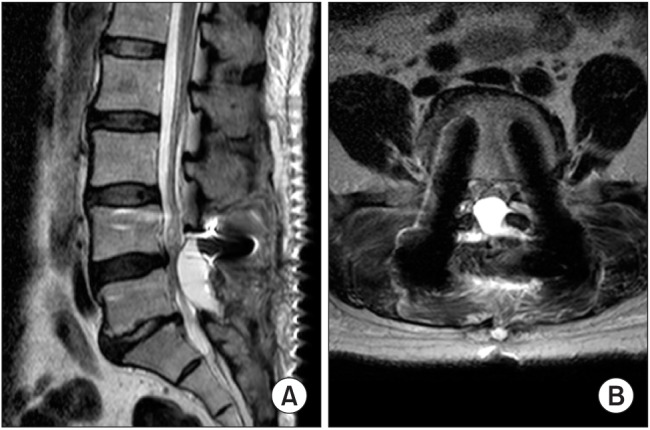Clin Orthop Surg.
2017 Jun;9(2):184-189. 10.4055/cios.2017.9.2.184.
Should We Check the Routine Postoperative MRI for Hematoma in Spinal Decompression Surgery?
- Affiliations
-
- 1Department of Orthopaedic Surgery, Kangbuk Samsung Hospital, Sungkyunkwan University School of Medicine, Seoul, Korea. xanthone@naver.com
- KMID: 2412286
- DOI: http://doi.org/10.4055/cios.2017.9.2.184
Abstract
- BACKGROUND
A postoperative magnetic resonance imaging (MRI) is performed as a routine to assess decompression of the spinal cord as well as to evaluate postoperative complications. The purpose of this study is to analyze the efficacy of postoperative MRI for hematoma in spinal decompression surgery.
METHODS
Between January 1, 2008 and January 31, 2015, 185 patients who underwent postoperative MRI after spinal decompression surgery were included in this study. We checked the history of the use of an anticoagulant or antiplatelet agent, withdrawal period, blood platelet count, and prothrombin time (international normalized ratio [INR]). We measured the total amount of suction drainage and duration until removal. We retrospectively reviewed the presence of hematoma and thecal sac compression. Postoperative prognosis was evaluated by a visual analog scale (VAS) and the Oswestry Disability Index (ODI).
RESULTS
Hematomas were found on postoperative MRI scans in 97 out of 185 patients (52.4%). Thirty patients had a thecal sac compressing hematoma: 7 in the cervical spine, 1 in the thoracic spine, and 22 in the lumbar spine. The occurrence of hematoma did not show significant difference according to the use of an anticoagulant (p = 0.157). The blood platelet count, prothrombin time (INR), and suction drainage duration did not have a statistically significant correlation with the occurrence of hematoma (p = 0.562, p = 0.506, and p = 0.429, respectively). The total amount of suction drainage was significantly different according to the presence of hematoma (p = 0.022). The total 185 patients had a significant decrease in the postoperative VAS score (p < 0.001), and the diminution of VAS score was not significantly different according to the occurrence of hematoma (p = 0.243). Even in the cases of thecal sac compressing hematoma, the reduction of VAS score was not significantly different (p = 0.689).
CONCLUSIONS
Postoperative MRI for hematoma in spinal decompression surgery has little effect on prognosis or management. Therefore, indiscriminate postoperative MRI should be avoided and MRI should be performed depending on the patient's status.
Keyword
MeSH Terms
Figure
Reference
-
1. Jackson R. Case of spinal apoplexy. Lancet. 1869; 94(2392):5–6.
Article2. Amiri AR, Fouyas IP, Cro S, Casey AT. Postoperative spinal epidural hematoma (SEH): incidence, risk factors, onset, and management. Spine J. 2013; 13(2):134–140. PMID: 23218510.
Article3. Sokolowski MJ, Garvey TA, Perl J 2nd, et al. Prospective study of postoperative lumbar epidural hematoma: incidence and risk factors. Spine (Phila Pa 1976). 2008; 33(1):108–113. PMID: 18165756.4. Babar S, Saifuddin A. MRI of the post-discectomy lumbar spine. Clin Radiol. 2002; 57(11):969–981. PMID: 12409106.
Article5. Ross JS, Masaryk TJ, Modic MT, Bohlman H, Delamater R, Wilber G. Lumbar spine: postoperative assessment with surface-coil MR imaging. Radiology. 1987; 164(3):851–860. PMID: 3615887.
Article6. Schubert GA, Diepers M, Hegewald AA, Seiz M, Thome C, Wilber G. Routine postoperative imaging early after lumbar decompression surgery: a prospective evaluation. Spine (Phila Pa 1976). 2013; 38(20):E1263–E1268. PMID: 23778369.7. Grane P. The postoperative lumbar spine: a radiological investigation of the lumbar spine after discectomy using MR imaging and CT. Acta Radiol Suppl. 1998; 414:1–23. PMID: 9465793.8. Malhotra A, Kalra VB, Wu X, Grant R, Bronen RA, Abbed KM. Imaging of lumbar spinal surgery complications. Insights Imaging. 2015; 6(6):579–590. PMID: 26432098.
Article9. Awad JN, Kebaish KM, Donigan J, Cohen DB, Kostuik JP. Analysis of the risk factors for the development of postoperative spinal epidural haematoma. J Bone Joint Surg Br. 2005; 87(9):1248–1252. PMID: 16129751.
Article10. Kou J, Fischgrund J, Biddinger A, Herkowitz H. Risk factors for spinal epidural hematoma after spinal surgery. Spine (Phila Pa 1976). 2002; 27(15):1670–1673. PMID: 12163731.
Article11. Agnelli G, Piovella F, Buoncristiani P, et al. Enoxaparin plus compression stockings compared with compression stockings alone in the prevention of venous thromboembolism after elective neurosurgery. N Engl J Med. 1998; 339(2):80–85. PMID: 9654538.
Article12. Platzer P, Thalhammer G, Jaindl M, et al. Thromboembolic complications after spinal surgery in trauma patients. Acta Orthop. 2006; 77(5):755–760. PMID: 17068706.
Article13. Gerlach R, Raabe A, Beck J, Woszczyk A, Seifert V. Postoperative nadroparin administration for prophylaxis of thromboembolic events is not associated with an increased risk of hemorrhage after spinal surgery. Eur Spine J. 2004; 13(1):9–13. PMID: 14615928.14. Cain JE Jr, Major MR, Lauerman WC, West JL, Wood KB, Fueredi GA. The morbidity of heparin therapy after development of pulmonary embolus in patients undergoing thoracolumbar or lumbar spinal fusion. Spine (Phila Pa 1976). 1995; 20(14):1600–1603. PMID: 7570175.
Article15. Wen DY, Hall WA. Complications of subcutaneous low-dose heparin therapy in neurosurgical patients. Surg Neurol. 1998; 50(6):521–525. PMID: 9870811.
Article16. Kao FC, Tsai TT, Chen LH, et al. Symptomatic epidural hematoma after lumbar decompression surgery. Eur Spine J. 2015; 24(2):348–357. PMID: 24760464.17. Aono H, Ohwada T, Hosono N, et al. Incidence of postoperative symptomatic epidural hematoma in spinal decompression surgery. J Neurosurg Spine. 2011; 15(2):202–205. PMID: 21529204.
Article
- Full Text Links
- Actions
-
Cited
- CITED
-
- Close
- Share
- Similar articles
-
- Early Decompressive Surgery for Compressive Neuropathy by Hematoma after Posterior Spinal Decompressive Surgery
- Hemorrhagic Complication after Spine Surgery
- Spontaneous Subdural Hematoma at Thoracolumbar spine: A Case Report
- Immediate Revision Surgery due to Post-Anterior Cervical Discectomy and Fusion (ACDF) Spinal Epidural Hematoma
- Spontaneous Spinal Epidural Hematoma: Case Report


